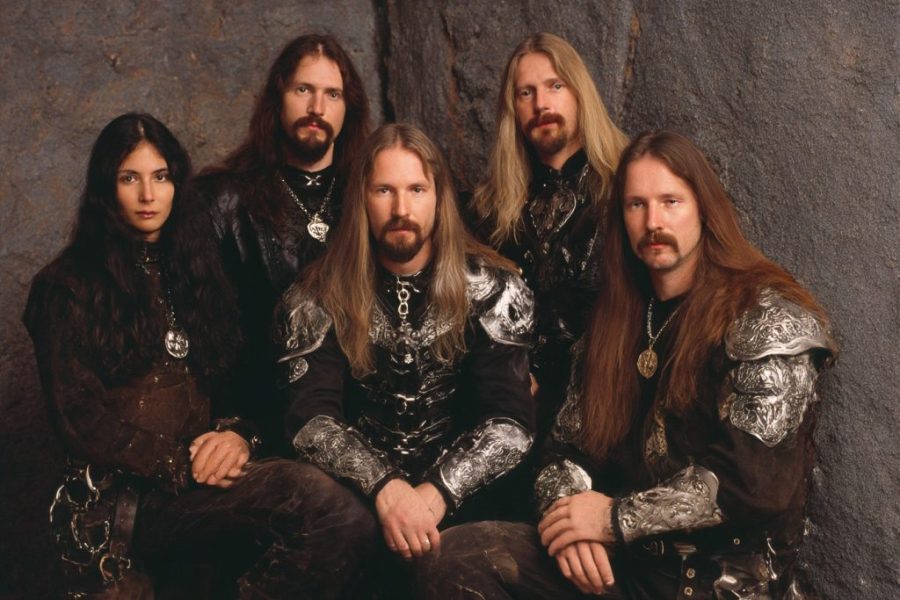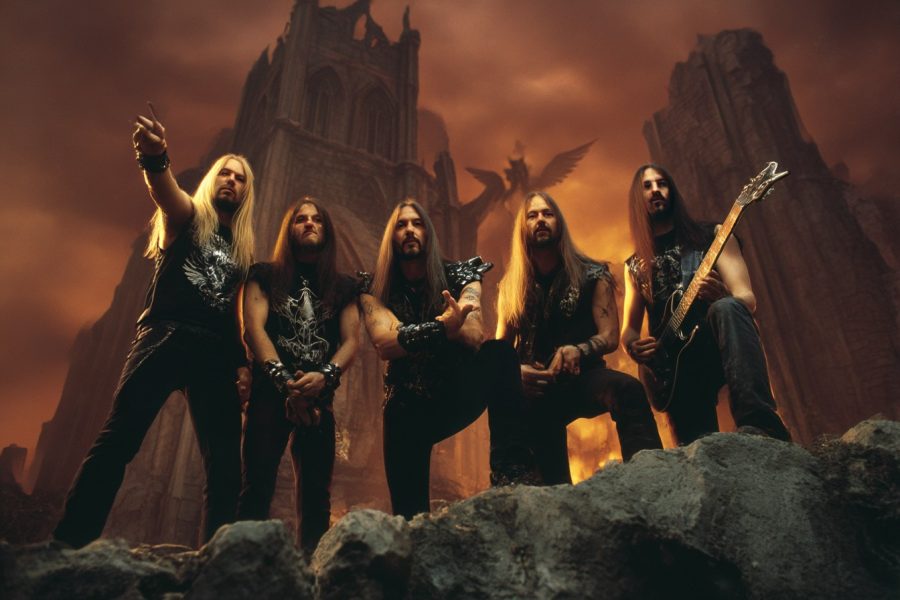I still have the exact moment burned into my memory—standing in Amoeba Records in San Francisco, sometime in the summer of ’97, flipping through the import section and stopping dead at an album cover featuring a knight holding a massive hammer. The band name, HammerFall, was emblazoned across the top in a font that would’ve looked perfectly at home on an album from 1983. The cover art—a warrior in full medieval armor looking like he’d stepped straight off a Dungeons & Dragons manual—seemed almost defiantly out of step with the times.
It was 1997, for Christ’s sake. Nu-metal was ascendant in America. In Scandinavia, black metal had reached its apex of cultural influence. The notion of releasing an album with unironic songs about brotherhood, metal warriors, and medieval battles seemed like commercial suicide. Even the classic metal bands had largely abandoned this territory—Priest was experimenting with industrial elements, Maiden was struggling through the Blaze Bayley era, and most of the second-tier 80s metal acts had either broken up or were languishing in obscurity.
Yet here was this Swedish band, proudly waving a banner for a style of metal that conventional wisdom had declared not just unfashionable but extinct. I remember feeling almost protective as I carried the CD to the counter, like I was rescuing some endangered species. The clerk—a guy with snake bite piercings and a Deftones shirt—actually smirked when he rang it up. “Really? This looks like some medieval cosplay shit,” he said. I just shrugged. If I’d been quicker, I might have noted that his beloved Deftones would be just as dated in twenty years, but the comeback always hits you on the drive home, doesn’t it?
Back in my apartment, I slid the disc into my player with a mixture of curiosity and trepidation. What if it was terrible? What if this was just some sad pastiche of better bands from better days? The opening acoustic guitar of “The Dragon Lies Bleeding” filled the room, and I braced myself for disappointment…
And then the full band kicked in, and I damn near fell off my couch.
This wasn’t some pale imitation. This wasn’t a nostalgic cash grab or a half-hearted revival. This was the genuine article—traditional heavy metal played with conviction, precision, and most importantly, absolutely zero apology for what it was. Joacim Cans’ voice soared over Oscar Dronjak’s immaculately constructed riffs with the kind of confidence you can’t fake. By the time the chorus hit, I was throwing devil horns in my empty living room like it was 1986 all over again.
“Glory to the Brave” arrived at a moment when traditional heavy metal was at its lowest cultural ebb. The style that had once filled arenas was now relegated to the most niche corners of the underground. And yet, HammerFall approached their debut as if they were completely unaware of this fact. There’s not a hint of irony or self-consciousness across the album’s 45 minutes—just unapologetic, gloriously melodic heavy metal.
The genius of the album is that while it’s clearly reverent toward its influences (Priest, Accept, Maiden, early Helloween), it never sounds like a museum piece. The production—crisp, powerful, but not over-processed—gives the material a freshness that transcends mere revival. Stefan Elmgren’s lead guitar work balances technical flash with melodic sense, while the rhythm section of Magnus Rosén and Patrik Räfling provides the kind of rock-solid foundation this style demands. But it’s the songwriting that makes “Glory to the Brave” more than just a well-executed exercise in nostalgia.
Take the title track—a power ballad that in lesser hands might have been cheesy but here achieves a genuinely emotional resonance. When Cans sings about fallen warriors and brotherhood, there’s a sincerity that cuts through any potential kitsch. The song builds with the kind of patience and dynamics that the best 80s ballads had, erupting into a soaring guitar solo that still gives me goosebumps twenty-five years later.
Or “HammerFall,” the self-titled anthem that became their signature song. That opening riff—simple but instantly memorable—sets the stage for a metal manifesto that feels less like a throwback and more like a declaration of principles. It’s the sound of a band planting their flag and declaring “This is who we are, take it or leave it.”
The album’s success in Europe was a shock to the metal establishment. Here was this defiantly traditional band selling serious numbers at a time when the conventional wisdom said their style was dead and buried. They weren’t just finding an audience; they were connecting with fans in a way that suggested there was a deep hunger for this sound that had been overlooked by labels and media alike.
I remember interviewing Oscar Dronjak around 2001 when they were touring for “Renegade,” and I asked him about the decision to form HammerFall at such an inhospitable time for traditional metal. He laughed and said, “We didn’t think about it that way. We just played the music we loved and that wasn’t being made anymore. We had no expectations beyond maybe pressing a demo and playing a few local shows.” That lack of calculation, that purity of intent, shines through on “Glory to the Brave.”
The ripple effect of HammerFall’s success was immediate and far-reaching. Suddenly, labels that had dismissed traditional metal as a commercial dead end were signing bands that proudly displayed their 80s influences. In Germany, Primal Fear and Brainstorm emerged. In Finland, Stratovarius found a wider audience. In Italy, Rhapsody (later Rhapsody of Fire) took the symphonic elements to new heights. What had been a scattered underground scene was coalescing into something resembling a movement, and “Glory to the Brave” was a significant catalyst.
I caught HammerFall on their first proper U.S. tour, playing a half-filled club in Los Angeles. The crowd was this weird mix of aging metalheads who’d kept the faith through the 90s and younger fans who’d discovered traditional metal through European imports and were experiencing it live for the first time. What struck me was the pure joy in that room—both from the band, who played with the enthusiasm of guys who never expected to have an audience outside Sweden, and from the fans, who sang every word like these songs had been part of their lives for decades rather than months.
After the show, I ran into a buddy who’d spent the 90s drumming for various death metal bands. He looked almost embarrassed to have been spotted at a HammerFall gig. “I just came for the novelty,” he claimed, but I’d seen him air-guitaring to “The Metal Age” when he thought no one was watching. That was the thing about HammerFall—their sincerity was contagious, breaking through even the most carefully constructed veneer of extreme metal credibility.
Listening to “Glory to the Brave” now, what strikes me is how fresh it still sounds. Unlike some revival acts that end up trapped in amber, forever recreating a specific historical moment, HammerFall managed to capture the spirit of traditional metal while giving it a vitality that transcended mere homage. Yes, all the elements that defined the genre are there—the soaring vocals, the melodic guitar work, the anthemic choruses—but they’re executed with a conviction and energy that makes them feel timeless rather than dated.
The album’s legacy extends far beyond its own considerable merits. “Glory to the Brave” didn’t just reintroduce a style that had been prematurely relegated to the history books; it helped create space for an entire subgenre to flourish again. The current health of traditional heavy metal—from the retro-thrash movement to the new wave of traditional heavy metal (NWOTHM) bands like Enforcer and White Wizzard—owes a significant debt to HammerFall’s willingness to wave that flag when it was deeply unfashionable to do so.
My original CD copy is long gone, worn out from repeated plays and eventually replaced with vinyl when I embraced the analog revival. But every time I put it on, I’m transported back to that moment in my apartment in ’97, experiencing the strange cognitive dissonance of hearing something so firmly rooted in the past that somehow managed to sound like the future.
I’ve always been fascinated by those pivot points in musical history—the albums that arrive at exactly the right moment to either define a new direction or, in this case, reclaim territory that had been abandoned. “Glory to the Brave” stands as a testament to the power of making the music you love without regard for prevailing trends or commercial considerations. HammerFall believed in traditional heavy metal when virtually no one else did, and that belief turned out to be not just artistically valid but, somewhat miraculously, commercially viable.
In an era where seemingly everything is available at the click of a button, it’s hard to convey just how revolutionary it felt to hear “Glory to the Brave” in 1997. It was like finding a portal to an alternate timeline where metal had evolved differently, where the foundational values of melody, hooks, and unabashed enthusiasm had never gone out of style. HammerFall didn’t change heavy metal’s core DNA; they simply reminded everyone why we fell in love with it in the first place.
And for that, they deserve nothing less than glory.

